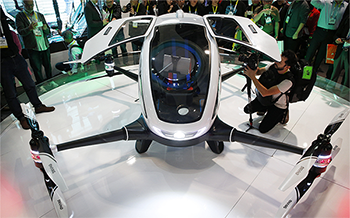Panelists: Moderator Gregory J. Bowles, director of European regulatory affairs and engineering, General Aviation Manufacturers Association; Nicholas K. Borer, principal investigator, Aeronautics Systems Analysis Branch, NASA’s Langley Research Center; Lowell Foster, flight test engineer, FAA’s Small Airplane Directorate; Rick Peri, vice president for government and industry affairs, Aircraft Electronics Association; Andy Supinie, director of aerospace sciences, Textron Aviation.
by Ben Iannotta, Aerospace America editor-in-chief
The general aviation industry has been hampered by an out-of-date FAA certification rule that has driven up the costs of aircraft and too-often stifled innovation, but a solution could be on the way, said experts June 16 at AIAA AVIATION 2016 in Washington, DC.
A rewritten part 23 rule covering aircraft up to 19 passengers will be in place by the end of the year, predicted Greg Bowles of the General Aviation Manufacturers Association.
Bowles was referring to the FAA target date of Dec. 16 for the new rule.
The new rule makes a “fundamental philosophical” change away from “prescriptive language to the maximum extent possible,” said Rick Peri, who is in charge of government and industry affairs at the Aircraft Electronics Association.
Bowles, who moderated the session, “Restoring the Foundation of Aviation,” gave an example of what’s meant by less prescriptive. He said that to avoid burnable material aboard general aviation aircraft, the current rule defines how a burn test must be conducted. The new rule specifies not to use burnable materials.
Regarding safety, Bowles showed a chart with a frustratingly flat line indicating no improvement in recent years in general aviation fatalities.
“Look how stable that is,” he said.
Several panelists suggested that this fatality line will shift in a favorable direction because of the new rule’s more welcoming approach to innovation.
“The bottomline is: New technology enhances safety,” said Andy Supinie of Textron Aviation, a merger of Cessna and Beechcraft, including the Hawker brand.
With a more welcoming approach to innovation, Peri said that “autonomous” general aviation is on the horizon.
FAA Flight Test Engineer Lowell Foster said overall, he sees reason for optimism about restoration of the industry, which is currently dominated by decades-old aircraft.
“I think we’re in a transition to a new growth phase, and one that could be even neater than what we’ve done in the past,” Foster said.
The panelists were hopeful that the shift in philosophy will usher in innovations that could reduce the costs of general aviation planes and lead to bold, new aircraft designs. Until now, certifying new technologies has often been “cost prohibitive,” said Peri of the Aircraft Electronics Association.
Specifically, several panelists said the new part 23 could open the door to applying entirely new approaches, such as the distributed electric propulsion technology to be tested by NASA’s piloted SCEPTOR plane, short for Scalable Convergent Electric Propulsion Technology and Operations Research.
The panel also raised the infrastructure challenges posed by electric propulsion. Nick Borer, a principal investigator at NASA’s Langley Researcher Center, noted that there are no electric charging stations he’s aware of at airports.
He said at least initially, the following needs to be considered: “Can we get some of the benefits of electric propulsion without challenging the infrastructure?”
He added that a possibility could be fuel cells, a technology he works on for NASA.

